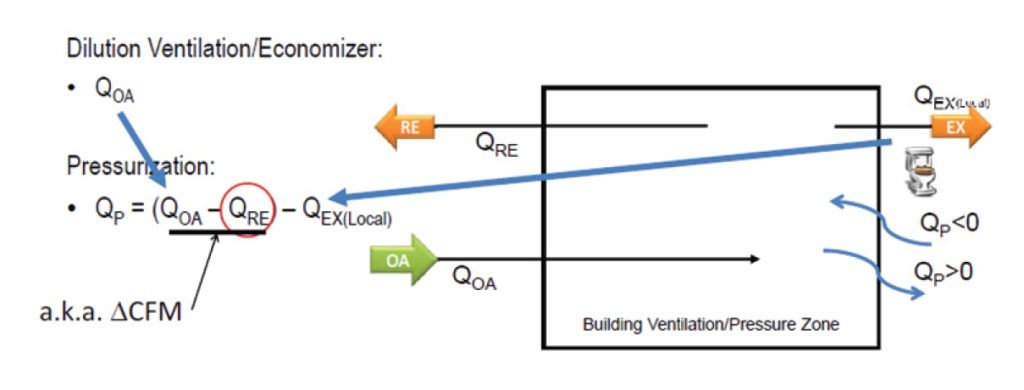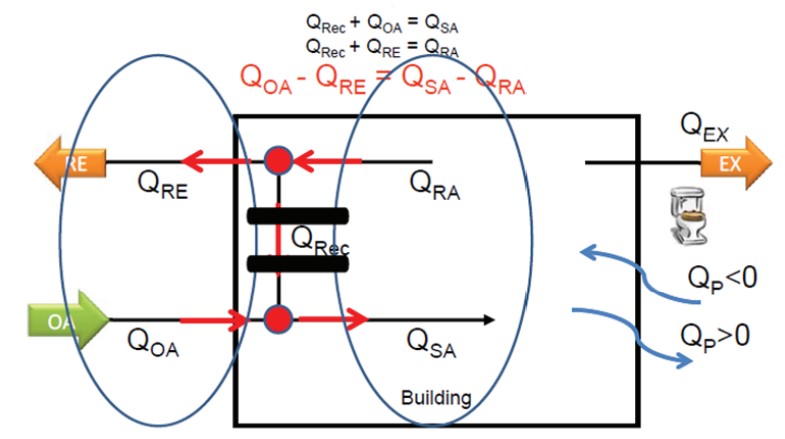An integrated “all‐airflow” control strategy uses airflow measurement at key measurement locations to provide the minimum ventilation requirements for IAQ and the proper intake/exhaust differentials to maintain the pressurization airflow between exterior or interior adjacent pressure zones. The technique has numerous advantages over static pressure control strategies. The primary reasons are:
Building pressure is maintained by controlling the pressurization flow, which is the difference between the mechanical system’s “ins” and “outs”. Building static pressure measurements cannot isolate the pressurization flow. Static pressure measurements are affected by wind, stack, and floor (e.g., doors opening/closing) pressure variations.
Compartmentalized pressure zones cannot be maintained using a static pressure control strategy.
Air handlers are designed based on airflow rates. Strategies that control static pressure cannot ensure that the design minimum and/or maximum airflow rates are provided.
Outdoor air intake flow rate variations during DCV and modulating economizer operation may result in building/space pressurization issues when a static pressure control strategy is used since there is no direct measurement to confirm that an adequate rate of outdoor air and/or the proper airflow differential for pressurization is maintained.
In addition, many static pressure control strategies directly reset damper positions, which are not linear to airflow, can create control/fan instability, and fail without an adequate fault feedback detection system (i.e., damper position feedback is inadequate).

Regardless of the type of system, the mechanical “ins” and “outs” must be measured and controlled to maintain building pressure. If the “ins” are greater than the “outs,” the pressurization airflow rate is greater than zero, and the pressure zone is “positive.” If the relationship is vice versa, the pressure zone is “negative.” If the “ins” equals the “outs,” the pressure zone is neutral.
The outdoor airflow rate (QOA) is controlled based on minimum ventilation requirements for code compliance (i.e., IAQ), or in systems with an airside economizer, the outdoor airflow rate required to provide the supply air temperature desired. Any local exhausts (QEX), whether from toilet exhausts, equipment, or laboratory hoods, are controlled to maintain the exhaust requirements for the application. As a result, the only variable that can be controlled to achieve proper building pressure is the relief airflow rate (QRE). Since the relief airflow path is not always able to be measured with adequate accuracy, control of the differential between the outdoor and relief airflow rates is conceptually a better way to look at pressurization airflow control.
Alternate Measurement Paths on Recirculating Air Handling Systems
Accurate differential airflow measurement of the intake and relief air paths is challenging in recirculating air handling system due to placement limitations between the louvers (or hoods) and control dampers. Differential airflow tracking generally requires measurement accuracies of ± 3% or better on today’s tight building designs. Unless there is significant ducting, the intake path will rarely result in measurements with accuracies better than ±5% of flow. The relief air path is typically worse, particularly in recirculating supply/return fan systems. Differential flow inaccuracy is amplified significantly as the flow differential decreases. A ±5% measurement error of the intake and relief airflow paths does not result in a ±5% error of the flow differential. Therefore, an alternate measurement location must be selected to determine ΔCFM. Fortunately, an alternate measurement location exists that not only provides a better location for measurement but also provides a method for verification of airflow rates.

Two equations can be created for each of the two red dots in the diagram. When the two equations are subtracted from each other (i.e., maintaining the integrity of the equation), the result shows that the supply airflow rate less the return airflow rate (QSA‐QRA) is equal to the outdoor airflow rate less the relief airflow rate (QOA‐QRE). Therefore, the latter can be used to determine ΔCFM. In addition, if the air handling unit is set to 100% recirculation mode (intake and relief dampers closed, recirculation damper open), the reading from supply airflow measurement device can be compared to the reading of the return airflow measurement device. This is particularly advantageous in applications where one of the measurement locations is marginal, and one airflow station can be used to field adjust the second.
Implementing an integrated ‘all-airflow’ control strategy not only ensures superior building pressurization but also contributes significantly to maintaining high indoor air quality. Understanding and adopting these methods are crucial for modern building systems. Explore further how these strategies can optimize your building’s performance and IAQ.

© 2023, EBTRON, Inc.
